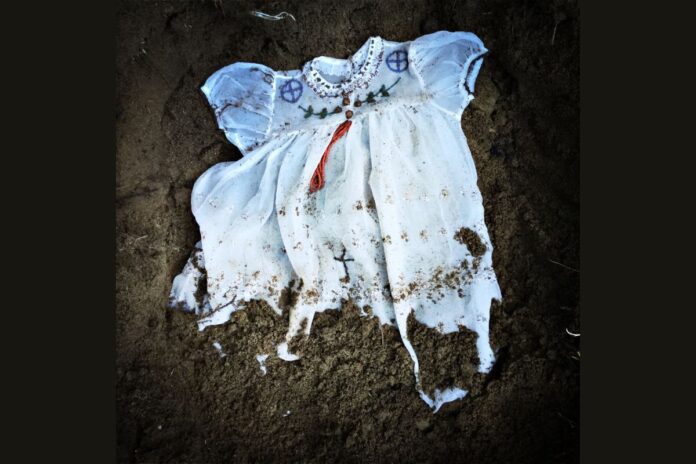
WARNING: RESIDENTIAL SCHOOLS
This article contains mention of residential schools and resulting deaths. Those seeking emotional support and crisis referral services can call the 24-hour National Indian Residential School Crisis Line: 1-866-925-4419.
Anishinābe artist Jobena Petonoquot’s exhibit, Rebellion of My Ancestors, is currently on display at the Ottawa Art Gallery (OAG). It is the gallery’s first ever solo exhibit by an Algonquin-Anishinābe artist.
Incorporating printmaking, photography, beadwork and fibre art, Rebellion of My Ancestors explores Petonoquot’s family history and lived experiences with colonialism and Christianity.
Rebellion is a strong theme of the exhibit. Petonoquot drew inspiration from her half-Algonquin, half-Irish grandfather, who grew up at the end of the Victorian era and continued to hunt and trap on the land, despite colonial powers forbidding it.
“He’s a true inspiration for me, because he always reminded me to be proud of who I am,” she said.
Growing up on the Kitigan Zibi Reserve outside of what is now known as Ottawa, Ont., Petonoquot was surrounded by art. Kyle St-Amour-Brennan, Petonoquot’s cousin, remembers his aunts making tactile artworks like birch bark weavings, hand carved mailboxes and hair brooches.
“I feel like we kind of grew up around art, and art in the most untraditional ways,” St-Amour-Brennan said. “You kind of don’t realize it’s art, because it’s something your aunts do, something that’s part of [your] culture, until you get out of that context and start recognizing it as an incredible, beautiful craft skill.”
The exhibit contains many references to the natural world, inspired by Petonoquot’s grandfather’s deep connection to nature. Delicate floral beadwork is sewn onto white baptism gowns and fallen cedar branches cushion Victorian-era china cups.
The exhibit was co-curated by OAG curator Rebecca Basciano and executive director of Centre d’art daphne, Lori Beavis.
The pink walls of the exhibit cocoon viewers like a womb and force them to reflect on artwork that is uncomfortable and beautiful, Basciano said. She said the contrast between the natural world and symbols of colonialism and Christianity is meant to provoke reflection and discussion among viewers.
“Resilience Repugnance,” the centrepiece of the exhibit, captures the tension between Canada and Indigenous peoples that remains prevalent.
To create this centrepiece, Petonoquot took Christian baptism gowns and applied beadwork to them. For her, this was an act of “Indigenizing” artwork that isn’t traditionally Indigenous. Applying the beads was a form of cultural resistance and a way for her to rebel against colonial powers, she said.
She taught herself beadwork when she was 25 with the encouraging words of her stepfather’s grandmother. While Petonoquot does not speak her Algonquin language, she said she feels connected to her culture and language through her beadwork.
When beading the gowns, Petonoquot said she was thinking about the children who attended residential schools. She buried the gowns in her home community of Kitigan Zibi and later unearthed them for the exhibit, displaying them on birch branches and cedar.
“I decided to bury [them] because I was thinking about funerary practices, and the act of letting go, but not forgetting,” she said.
Petonoquot said “Resilience Repugnance” is a metaphor for Indigenous peoples and the colonizers. From afar, the intricate beadwork and gowns appear beautiful and untouched. However, the closer one gets, the true meaning of the piece shines through.
“I focus on beauty a lot in my work because I want to use it as a trap to make people look,” she said.
This trap helps Petonoquot start a conversation about the past and present lived experiences of Indigenous peoples.
Humor is another tool Petonoquot uses to rebel. Artworks in the exhibit, including “Colonial Suvourineer” and “We all drank tea with the Queen” are a tease to the viewer, poking fun at problematic Indigenous stereotypes.
“In native culture, we are always laughing. We even laugh about bad things that happen to us, because it’s a way of dealing with things in a positive way,” she said.
Viewers have been responding positively to the exhibit, according to Basciano.
“There has been a lot of great feedback. I think a lot of people are reflecting—it’s exactly what [Petonoquot] hoped for,” Basciano said.
St-Amour-Brennan is especially proud of Petonoquot as this exhibit is specific to their shared community, culture and ancestry.
“The thing I appreciate about [Petonoquot’s artwork] is it is so personal, and it talks to the specificity and intersectionality between religion and family and also Indigeneity,” he said.
Petonoquot hopes this exhibit educates everyone, Indigenous or not, and opens up a dialogue about the ongoing experiences of Indigenous peoples in Canada.
“This is not just an Indigenous problem. It’s a Canadian problem,” Petonoquot said.
Rebellion of My Ancestors is on display at the OAG until Aug. 14. Admission is free.
Featured image provided by Jobena Petonoquot.





